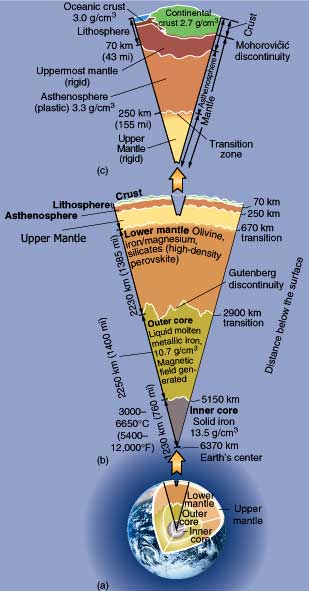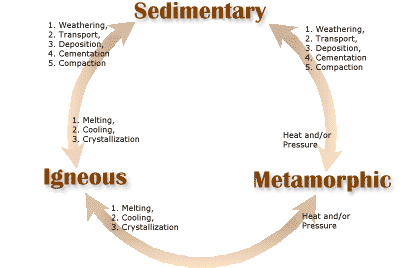THE NATURAL ENVIRONMENT
Geography 101
ToC
EARTH
Geomorph
Interior
Plates
History
Hot Spots
Interior of Earth
 Layers
Layers
To understand the surface features of planet Earth, it helps to have some understanding of its interior structure. Just as we looked upward through the layers of the atmosphere, we now look downward into the layers of inner Earth.
Early in the planet's formation, materials separated by density with the heavier elements and minerals migrating toward the center and the lighter ones floating to the surface. This sorting process produced a series of thick, concentric shells of differing density and composition.
At the very center, extending outward more than 1/2 the radius of the planet is the core. The core is composed of iron and its motion produces our magnetic field. Oddly, the solid inner part of the core rotates slightly faster than the rest of the planet.
Between the core and the surface layer lies the mantle. The mantle is much less dense than the core and includes most of Earth's volume. Lava flows in Hawai'i come directly from the upper part of the mantle.
Covering the mantle at the surface is a thin layer called the crust. There are two varieties of crust, which is a kind of a bubbly, light, mineral froth coating the mantle. Continental crust is very light (2.7 grams/cm sq.) and very old, some as old as Earth itself. It's just too light to be pushed down into the interior. Most continental crust is granite. Oceanic crust, on the other hand, is denser (3.0 grams/cm sq.) and much younger. It is also much thinner, averaging about 5 kilometers (3 miles) thick compared to continental crust's 40 kilometers (25 miles). Most oceanic crust is basalt.
The crust and mantle are separated by a curious break called the Moho (or Mohorovicic discontinuity), which was discovered by analysis of seismic waves. The Moho is much deeper under mountain ranges and continental crust than under oceanic crust. In other words, if you want to dig a hole to the Moho (which was tried by the Russians), it would be shorter to go through oceanic crust.
|
|
BOX 1 |
Because of cooling at Earth's surface, a bit of the upper mantle and the entire crust have hardened together into a rigid layer called the lithosphere. The lithosphere is of great interest to geomorphologists because its motions produce the largest features at Earth's surface. The lithosphere is about 80 kilometers (50 miles) thick on average. Beneath it lies another bit of the mantle called the asthenosphere. This layer is semi-molten, which allows the rigid lithosphere to slide over it.
Rocks
 Understanding
the development of landforms requires understanding properties of
the materials they are made of. The most basic distinction between these
materials relates to their formation. The youngest rock,
igneous rock, forms
when molten
magma (or lava, which is magma that flows onto the surface) cools and
solidifies. Examples are basalt and granite. In the creation of landforms,
it is important to distinguish between two
classes
of igneous rock, felsic and mafic.
Felsic rocks are high in silica (aluminum and oxygen), and have low
melting points and low densities. Mafic rocks are higher in iron and
magnesium, have higher melting points and higher densities. Sea floor
crust, for example, is mafic basalt, while many continental igneous rocks
are
felsic granite. The distinction is important when discussing volcanoes
because felsic magmas
tend
to produce explosive eruptions, while mafic magmas produce the gentler,
high volume flows that characterize Hawaiian volcanoes.
Understanding
the development of landforms requires understanding properties of
the materials they are made of. The most basic distinction between these
materials relates to their formation. The youngest rock,
igneous rock, forms
when molten
magma (or lava, which is magma that flows onto the surface) cools and
solidifies. Examples are basalt and granite. In the creation of landforms,
it is important to distinguish between two
classes
of igneous rock, felsic and mafic.
Felsic rocks are high in silica (aluminum and oxygen), and have low
melting points and low densities. Mafic rocks are higher in iron and
magnesium, have higher melting points and higher densities. Sea floor
crust, for example, is mafic basalt, while many continental igneous rocks
are
felsic granite. The distinction is important when discussing volcanoes
because felsic magmas
tend
to produce explosive eruptions, while mafic magmas produce the gentler,
high volume flows that characterize Hawaiian volcanoes.
Sedimentary rocks form when small bits of mineral and other material build into thick deposits. The material at the bottom of the deposit hardens under pressure into rocks like sandstone, limestone, and shale. Sedimentary rock is a paleontologist's delight because it forms in horizontal layers that often preserve fossil remains. The individual layers, or strata, can usually be dated fairly accurately by examining the sediment content and, thus, the sedimentary record provides a tidy chronology of the history of life, neatly arranged and separated into layers.
 Metamorphic
rocks form when either igneous or sedimentary rock comes under
intense heat and pressure. The mineral structure completely changes producing
a solid crystalline mass with a complex internal pattern arising from
the original matrix of materials from which it formed. Examples
include marble
and gneiss.
Metamorphic
rocks form when either igneous or sedimentary rock comes under
intense heat and pressure. The mineral structure completely changes producing
a solid crystalline mass with a complex internal pattern arising from
the original matrix of materials from which it formed. Examples
include marble
and gneiss.
The Hawaiian Islands contain all the three major rock types, being composed mostly of igneous basalt, with some sedimentary rock, such as old reef structures, and a few metamorphic species, such as the unusual garnet bearing rocks of the Salt Lake area on O'ahu.
